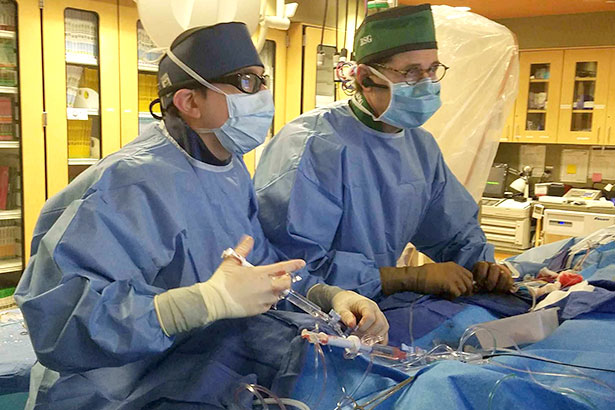The program uses a unique algorithm to determine which methods are most effective to achieve the best outcome

The use of novel technology in the newly established coronary artery chronic total occlusion (CTO) program at Englewood Hospital and Medical Center is giving many patients a new lease on life.
CTOs are arteries that are 100% blocked for three or more months. They are responsible for clinically significant decreases in blood flow, and they can affect the survival and quality of life of hundreds of thousands of people who have artery blockages. CTOs also are identified in up to 31% of patients referred for coronary angiography.
Now, a procedure called percutaneous coronary intervention (PCI) can successfully treat over 90% of patients with CTOs and improve their quality of life.
While some patients with CTOs are treated with bypass surgery, 60% of them are treated with only prescription drugs. Many of these patients also are told that nothing can be done to open their CTOs using standard angioplasty and that they may end up living with chronic angina. Historically, fewer than 5% of CTOs in the United States have been treated by traditional PCI, but now with novel techniques in use at selected medical centers, including Englewood Hospital, many patients can be effectively treated with PCI.

“Historically, using standard PCI techniques, the success rate was only about 40% to 50%,” said Aron Schwarcz, MD, an interventional cardiologist at Englewood Hospital. “With newer technologies and newer techniques, the success rate at Englewood Hospital exceeds 90%.”
Dr. Schwarcz, along with Richard Goldweit, MD, developed the CTO program at Englewood Hospital in 2015. The program uses a hybrid algorithm to determine which methods would be most effective to achieve a successful PCI outcome. There are three techniques to cross the CTO stenosis: using wires to enter the lesion, using the subintimal space to go around the lesion and reenter the vessel on the other side, or going retrograde past the lesion. Clinicians at Englewood Hospital have treated more than 60 patients since the program began, with nearly all experiencing a lower angina burden and an improved quality of life.
Dr. Schwarcz said clinicians should keep a few things in mind when managing coronary CTOs. First, not all patients have typical angina symptoms. “Patients don’t necessarily get chest pain or chest pressure. Some of our most symptomatic patients had chronic dyspnea on exertion and atypical chest discomfort as their angina,” he said. “You need a detailed history and workup to determine if the dyspnea or other symptoms are an anginal equivalent or from a different cause.”
Second, failing past treatments for CTOs doesn’t preclude an individual from receiving effective treatment with the new procedure.
In May 2015, one of the first patients to enter the CTO program at Englewood Hospital was a 57-year-old, small-business owner who was unable to work or travel due to crippling angina. He had a CTO of the left circumflex artery and had two previous failed attempts to fix the blockage. Physicians at Englewood Hospital treated the patient by opening the CTO using the novel PCI procedure.
“His case really stuck out in my mind. About a week after the procedure, we saw him for follow-up in the office, and he was ecstatic. He was feeling 100% better, and he was able to work at the level that he used to. He had no angina and no limitations,” Dr. Schwarcz said. “This case illustrates the types of patients that we can help and the benefit that we can give them.”
Posted September 2017
The program uses a unique algorithm to determine which methods are most effective to achieve the best outcome
